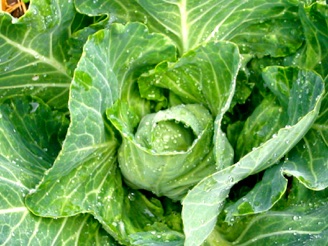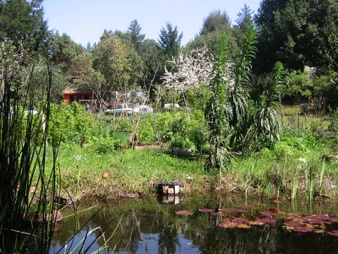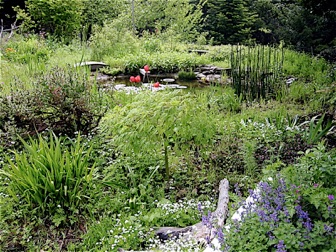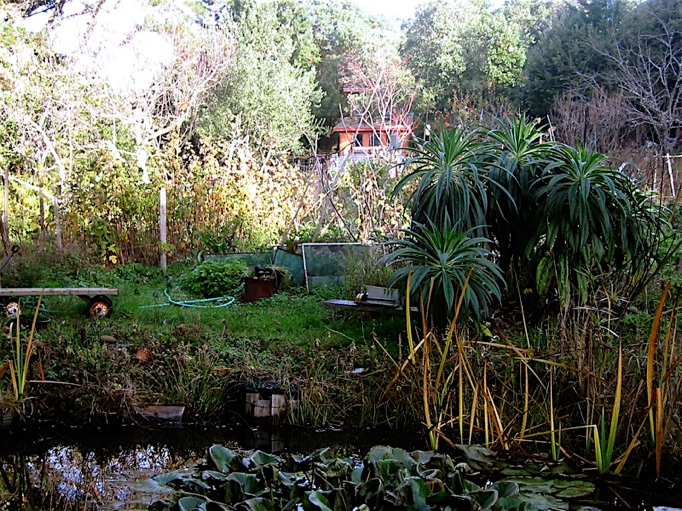


The Garden:
A vibrant living thing which feeds us.
Recognizing that the garden is a complex, dynamic environment, and not a mechanized factory for food production, is a key to a human scaled subsistence farming. It often appears that backyard gardeners in this country seek to emulate commercial production techniques, creating miniature versions of big agriculture, and repeating many of it’s mistakes. The standards of production that we have come to expect are predicated on the practices of an industrialized agriculture that has only been in effect for around 100 years. Yet through out the long span of post agricultural humanity, people in cooperation with plants, seasons, and available resources have fed themselves and created fuel and fiber.
My operating principle has always been; it can’t be that hard to survive, but the absolutely necessary addendum to this is: if we do the right thing. That may be the hardest thing. Who knows what the right thing is anymore? Generations of information and wisdom have been lost or set aside as agriculture has progressed and diminished. Left to ‘experts’, the practice of growing has been established and codified as an extractive process. Unfortunately, this is exactly the opposite way nature operates. The additive process of natural production is based on growth, which invariably brings decay. As the cycle repeats endlessly, countless generations of living organisms participate in transforming, recombining, and, adding to the raw materials that sustain everyone and everything on the planet.

Clues on the path home,
& for the birds.
The stories begin here,
and continue @:
Included so far:
▸ THE GARDEN
-
‣WATER
-
‣ENERGY


Water:
Water is An essential, primary consideration. Where is it? How much is there? & of course, What is the quality of the source? In our case, fortunately, we have a natural spring that flows year round, in winter it becomes the headwaters of a small creek, and in summer it moves below the surface. Unfortunately this amazing feature was located about 175 feet below, and 900 feet down range of the most hospitable area for the development of house and garden. We started out hauling water for drinking, cooking, and washing, clearly that wouldn’t be adequate, so, we purchased our first solar powered pump. It would have been easier to get a noisy, combustion engine driven model, but there was something in me that resisted becoming dependent on gasoline for water. The technology was just then improving to the point where reliable, inexpensive solar pumping was feasible.
Our first pump used a 48 watt solar panel and a small linear current booster- an electronic gizmo designed to adjust the current to volt ratio of the available power, so that on overcast days and at each end of the day the pump continued to run and slowly fill a 450 gallon surplus polyethylene olive curing tank. We also used black polyethylene pipe, an inert, chemically stable co-polymer, we later found this pipe was also resistant to freezing. After a deep winter freeze our neighbors PVC pipe had cracks spiraled down its length, while our poly line thawed out, ready for service. Naturally the spring was not located in the sun, so we had to run a line to a holding tank, another 450 gallon olive tank. Because of the terrain the gravity flow was just adequate to fill the tank on the road that bordered our land, but still lacked solar exposure. We had to string wire up the hill about 100 feet, this was a 12 volt DC system so we would need a heavy wire to keep line losses to a minimum. The first wire used was 12 gauge 3 conductor Romex, with the 3 wires twisted as one for each leg of the circuit. The limitations of this pump became apparent as it readily overheated. The small pump house enclosure I built was inadequate, and placed in a way that allowed accidental inundation. After replacing rusted bearings, ruptured diaphragms, and at one point the entire unit, it became clear we needed an upgrade. It was no wonder, as later I saw a catalog listing a quite similar pump as a replacement for an industrial carpet cleaner, clearly it was designed for lighter duty.




A hand dug pond was finished in 2001.
Energy:
As children of middle class suburbia, abundant electricity was a given, natural, necessity. By the time we arrived here at the top, we were conceptually committed to weaning ourselves from the grasp of Pacific Gas & Electric. Searching for land it seemed a delicate balance, and difficult task to locate a modest piece of land that was not unreasonably remote, and off the grid. We were pleased to find this place, with it’s small rough, shack of cabin, included an old 32 watt PHOTOWATT solar panel- and a very dead, very large, heavy equipment Battery.
My first task was to clean up the connections, check the electrolyte in the battery, & test the out-put of the panel. My only training for this was a childhood that included Radio Shack electronic hobby kits, and a little 12 volt DC experience from the Tattoo trade. After checking everything out I made a rustic junction box with 2 cut-off blade switches, for both battery and panel, a volt meter, and an automotive fuse for the output. When I hooked the battery to the panel- it began charging! This battery had been dead for a while- and I had no idea how it would perform. Plugging in our boom box with a 9 volt regulator, We were pleased to find it worked. Tapes & radio were most of our load. Our lighting at the time consisted of candles, kerosene lamps and a couple of 12 volt brake light bulbs. This system worked for several years, our needs were small enough, that using the shallow charge of an aged, big battery was adequate. We even raised a batch of chicks with a bigger 12 volt bulb powered this way, and were able to Tattoo powered by the sun!
Of course, energy likes to find ways to increase demand. There is no doubt about it, electric light rocks, and burns up a lot of amp hours, especially in the dead of winter. When we up graded the water system, the original 48 watt KYOCERA panel came up to our newly built house, augmenting the PHOTOWATT, making a big 80 watts. The increase in potential power made a difference at the end of the battery’s useful life, but, also encouraged more use of more lights. As our loads increased we had to upgrade our energy storage.
A word on loads:
When you explore the hardware requirements of an off grid, stand alone power system, you find the emphasis is usually on the energy demands of the devices and appliances that are embedded in our daily lives- then working back from there, to assess storage and generation requirements. To my mind, this puts the cart before the horse. It is perfectly reasonable to size a system from the other end, i.e. acquire the equipment you can afford, and then, determine what you are able to power. Photovoltaic panels can always be added, as budgets & demand increases. This approach automatically adds the important & often neglected concept of energy conservation to the mix, reducing expectations & assumptions about power consumption. When using a correctly sized system, a unique circumstance can arise; too much potential power.Where generation exceeds storage capacity, not using power is wasting the potential of your equipment. If this happens a lot, you know you can add loads or storage to your system. Here at the top, we are conservative energy consumers. One of the biggest reductions in power consumption we experience, is from our decision to do without the convenience of refrigeration. We do use a small 12 volt, solid state thermo-electric cooler seasonally, which coincidentally functions as a load diversion for the solar rich days of mid-summer, when our batteries are easily topped off after a few hours. After 23 years of non-refrigerated living, we know that it is both possible, and not a hardship.




These share buttons make it easy to share this site via the new paradigm of communication, and increase this site’s exposure. But, I don’t approve of the business model of social networking, or the tracking of user data and targeted marketing. More than ever media literacy needs to be learned and practiced. I have the distinct feeling that I am at some sort of crossroads of ethics- perched on the verge of something distasteful. However, As they say: “WHEN IN ROME.” Please, use at your own risk:
With these notions as my foundation, I seek to grow food as intuitively as my modern mind can manage. I defer to no expert opinion, but observe conditions, and approach the problems of pests and nutrients conservatively, mimicking nature with tolerance and adaptation. The results speak for themselves. As we daily, year round, eat fresh food from our garden. Our garden is large and diverse to guarantee this. Nearly anyone can grow something to eat, but relying on the garden for a constant supply of nutrition necessarily becomes a way of life. There is no separation in nature, a true integration of living and lively hood is a prerequisite for a natural process of living. Acquiring sustenance is an ongoing and necessary challenge that requires a commitment to the process.
The aphorism- the best fertilizer is the farmers shadow, exemplifies this principle. The work is not all difficult, but success depends seasonally, on daily participation, and observation. The cycles of the garden are always churning, there is no beginning or end to the garden, just the process. This can make starting a garden from scratch a challenge, but once the appreciation of cycles is established, a holistic approach develops priorities organically, and the wheel of the year turns evenly. My year is defined by tasks I take for granted, the seasons of new seeds, the seasons of new soil, the seasons of observant waiting and grooming, the seasons of abundant joyous growth and gathering, and the seasons of rest and recharge. Timing is one of the most critical components, a plant in it’s proper time, given a decent chance, can’t help but grow. The decent chance consists simply of adequate soil tilth, nutritive material, space, sun, and water. Tilth, the physical condition of the plant supporting soil assures adequate permeability to the essential elements of air and water, and encourages expansive root development so that the plant may find the resources it needs to grow and completing it’s lifecycle, fruit. Nutrition consists of organic material, anything that has lived, and the biota that supports the break down to it’s molecular components, along with the available minerals in the soil, these are the building blocks of new life. The space a plant occupies helps determine it’s size, and productivity crowding many plants together diminishes the available sunlight, nutrient base, and capacity of the plants. Solar exposure, is crucial, the sugars of life are created by the photosynthetic capacity of plants leaves, the fuel for this process is starlight from our nearest and dearest, the sun. Water keeps it all going, the presence or absence of water determines life spans and the adequacy of the plants purpose. some plants can survive Drought, but all plants need need water to grow, and flourish.

